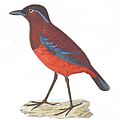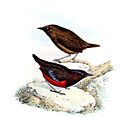Graceful pitta facts for kids
Quick facts for kids Graceful pitta |
|
|---|---|
 |
|
| Conservation status | |
| Scientific classification | |
| Genus: |
Erythropitta
|
| Species: |
venusta
|
| Synonyms | |
|
|
The graceful pitta (Erythropitta venusta) is a beautiful bird found in Sumatra, Indonesia. This small bird lives in wet montane forests, which are forests found in mountains. Sadly, the graceful pitta is facing a big problem: its habitat (the place where it lives) is shrinking. This means it is a vulnerable species, needing protection.
Contents
About the Graceful Pitta
The graceful pitta was first officially described in 1836. A German scientist named Salomon Müller gave it the scientific name Pitta venusta. He found these birds in western Sumatra. The word venusta comes from Latin and means "beautiful" or "lovely."
Today, the graceful pitta is part of a group of 15 birds called Erythropitta. This group was named by Charles Lucien Bonaparte in 1854. The graceful pitta is a unique species, meaning there are no different types or subspecies of it.
What Does the Graceful Pitta Look Like?
The graceful pitta is a small bird, about 18 cm (7.1 in) (7 inches) long. It has mostly black feathers with hints of red underneath. Its wings have bright blue stripes that stand out.
The lower part of its chest and its abdomen (belly) are a soft red color. The upper chest is dark brown with a touch of purple. Its legs can look purple-blue or light blue, and its eyes are dark brown. The bird's beak is black, and its tail is reddish-black.
Both male and female graceful pittas look very similar. Young birds, called juveniles, are mostly dark brown. They have less color variation than adult birds. Young pittas also have pinkish-grey feet, a beak with a red tip, and grayish eyes.
When a graceful pitta calls, it sounds like a high-pitched train whistle. The sound stays at the same level.
Where Do Graceful Pittas Live?
The graceful pitta lives in the highlands of Sumatra, Indonesia. These highlands are covered in thick tropical forests. These forests are home to many different kinds of plants, animals, and insects.
Graceful pittas prefer to live in dense, moist woods. They like places with a thick understory, which means lots of plants growing close to the ground.
However, these forests are disappearing quickly because of deforestation. This is happening a lot because of the high demand for palm oil. Indonesia is the biggest producer of palm oil in the world.
How Graceful Pittas Behave
The graceful pitta usually flies close to the ground. It moves through the trees, often at the same height as people's homes in residential areas.
Reproduction and Nests
Scientists have only recorded one graceful pitta nest so far, which was found in May. However, research suggests that these birds might breed from May to July. It's even possible they breed as early as February and as late as October.
Graceful pittas build their nests about 60 cm (2 feet) above the ground. They use materials like dead leaves, bamboo leaves, thin roots, old fibers, and moss. A female graceful pitta usually lays two to three eggs in each breeding cycle. Each egg is dull white with unique dark brown and gray-lilac spots.
Status of the Graceful Pitta
The graceful pitta is a very rare bird and is considered vulnerable. This means it is at risk of becoming endangered. Even though it has been legally protected from hunting since 1931, its main threat is still deforestation.
The loss of its forest habitat in Indonesia causes the graceful pitta's population to steadily decrease. As more forests are cut down, there are fewer places for these birds to live and thrive.
Gallery




